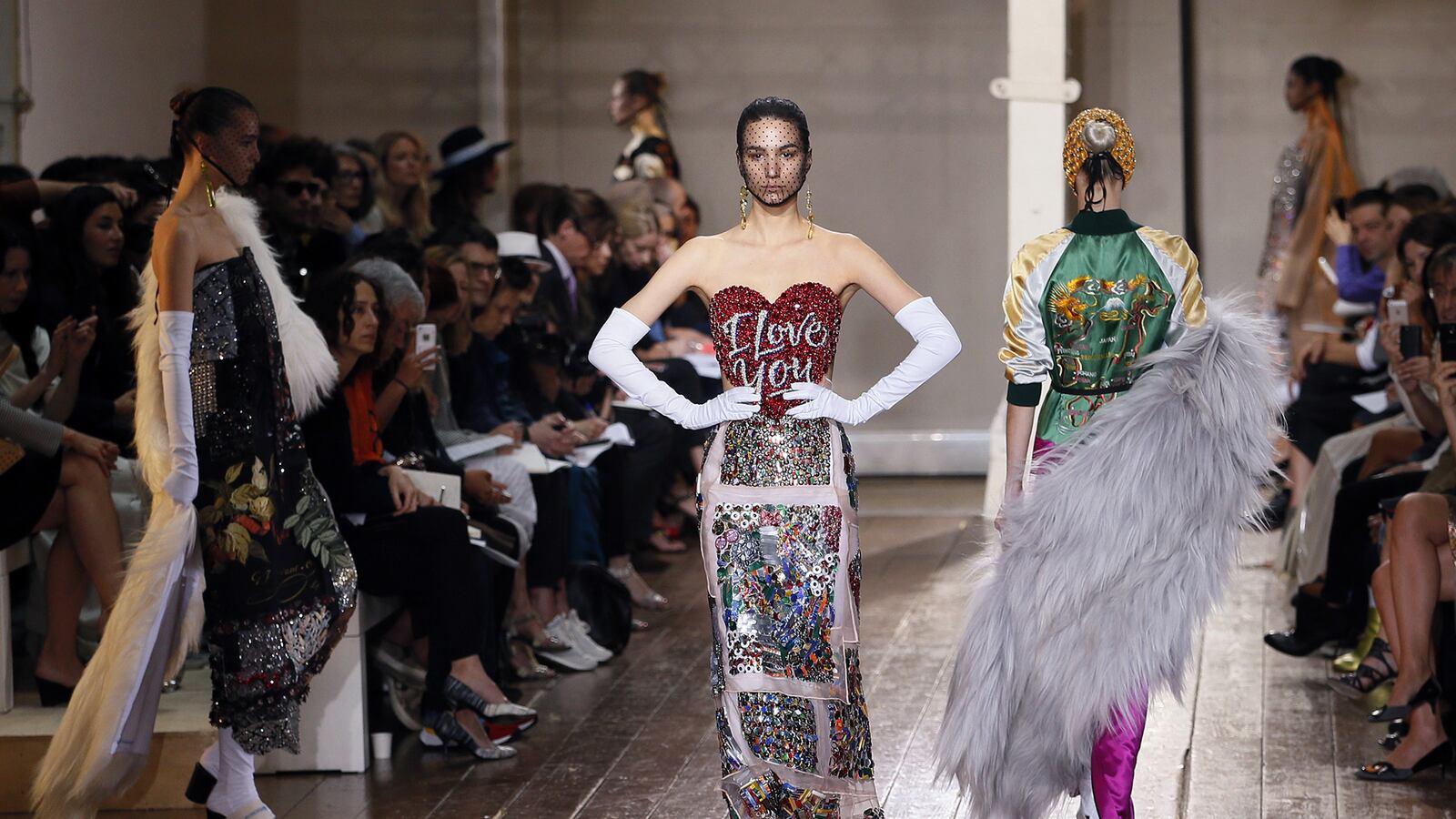
One of the discussions playing out on the runways in Paris at this year’s Couture Week might run something along the lines of: Is couture still couture when it looks like ready-to-wear but is none the less made to measure?
Or does it need to be full of drama and high-end finishes, à la Jean Paul Gaultier with his Sunset Boulevard meets the vampires collection, which culminated in the spectacle of the Eurovision Song Contest winner, Conchita Wurst, walking at this year’s couture show?
Or even outlandish, like Viktor & Rolf who created a collection of over-sized theatrical black designs in thick materials resembling stage costumes, for a show that began with the designers meditating like monks on a bed of raked Japanese sand.
For Mr. Gaultier, the answer would be that these are two different cultures. “Couture should not be like ready-to-wear when we have shops like H&M doing that kind of thing,” he told The Daily Beast backstage after the playful show where chocolate lollipops were handed out to reporters, as Wurst warbled into a camera. “One of the great things about couture is that fabulous workmanship and things that you can create,” he said.
And he should know. For Mr. Gaultier couture is big business. “It is not as big as perfumes, but it is bigger than ready-to-wear,” he added.
Call it the state of the nation, but in putting together the couture exhibition, “Les Années 50: La Mode en France 1947-1957,” which opens Saturday (July 12) at Paris’ main fashion museum, Palais Galliera, its director Olivier Saillard declared there has been more business in the past three years for couture than there has been for 10. A recent story in the fashion Bible, Women’s Wear Daily, cited growth in new markets from China to Germany and a younger generation interested in couture.
The Chambre Syndicale de La Couture was first developed by the British couturier Charles Frederick Worth and his sons in 1868. By 1946 there were 106 Official Haute Couture Houses. Today there are around a dozen members. And although some of the names on show at the Galliera exhibition are long gone like Jacques Fath, others are making a comeback and introducing their styles back into couture week.
The French house Azzaro staged its first show in 30 years on Thursday, as couture week came to a close, sending out glamour pusses in slinky dresses. Backstage the two young designers heading up the house, Arnaud Maillard and Álvaro Castejón, said: “Couture will always be about Paris. But our clients are everywhere, multi ethnic and cultural.”
In January, the newly revived Schiaparelli sent out its first couture collection in decades, presenting light, whimsical clothing.
While the Galliera exhibition celebrates French couture between the years of 1947 and 1957, some of the new growth in couture custom is attributed to newcomers from further afield, like the Chinese-born designer Yiqing Yin and Britain’s Ralph & Russo, which is the first British label to be accepted into the couture syndicate in Paris for close to 100 years. It is also attributed to new styles from younger designers like Bouchra Jarrar.
Some of it also has to do with this almost ready-to-wear look, or a more casual aesthetic from younger designers, which barely looks couture at all, depending, of course, on how many sequins you think should be sewn onto any given couture gown? In some moments this week, one could see a growing disparity between the glamorous, glimmering ostentatious designs of some of the older houses, and the almost too casual creations from some of the younger members of the couture syndicate in Paris.
Consider the trashy, silky sweatpants sent down the runway by Jarrar, complete with thick stripes running down the legs. However, Ms. Jarrar, alongside Yiqing Yin, is one of a new generation of designers helping fuel the growth, Mr. Saillard said, adding that couture today, stylistically, is a far cry from its heyday.
“They are trying to find their way to a new client base, a younger client base that wants simpler looks,” opined a veteran fashion reporter, as Armani sent spectacular floating, candy floss-like dresses down the runway, restoring my faith in the distinctive and luxurious beauty of couture. Armani’s designs were one of a number that made couture feel dressy, alongside Elie Saab and Versace.
Other younger designers showing in Paris during Couture Week include Alexandre Vauthier, who created finely worked clothing this year in an underground setting. “Couture is a huge business for me,” he said backstage. “I have clients from China to Dubai.” Or Dice Kayek, who raised some cheers for her sculptured dresses in bold colors that had one onlooker declare after the show on Thursday, “Now there is real couture.”
They are joined by Julien Fournié, a young French designer who launched his haute couture house in 2009, and is a guest member of the couture syndicate. Mr. Fournié is poised to debut his first ready-to-wear collection in December. “Haute couture is the laboratory for fashion,” he said. “Far from only commercial goals, couture should always take the best from tradition and innovation. This is the couture signature, not the silly cliché about red carpet gowns only. A couture dress is built together with the customer. It is very seldom that it comes down straight from the runway.”
The couture business has the potential for further growth, he added. “I believe that the reason why people have a new taste for couture these days is because after the financial crisis they are rediscovering in a new light the values of craftsmanship, of lasting finishes, of genuine know-how, far removed from the worst expressions of marketing,” Mr. Fournié said.
In recent years, he added, “couture has been growing a lot with new customers, younger ones, and from various countries. The emergence of stronger economics in places like Singapore, Malaysia, Hong Kong, Brazil, and Russia has added a new set of rich and young women to the usual set of princesses from the Middle East.” Mr. Fournié’s main customers come from Saudi Arabia, the United Arab Emirates, and Qatar, but also from Singapore, Rio de Janeiro, Moscow, Kazakhstan, and London. So yes, couture is alive and flourishing, thanks to wealth located far from its spiritual home of Paris.






